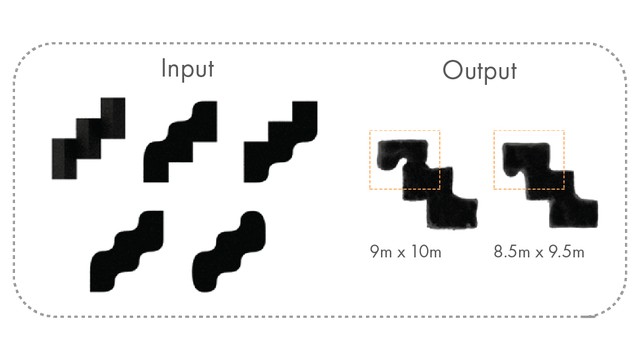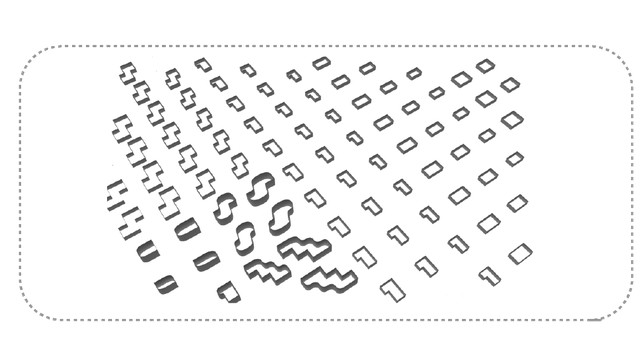Speculative Hybrids 2022, Denmark, Copenhagen
Investigating the generation of 3D conceptual architectural forms through the use of Machine Learning.






Design Thinking aims at solving problems that have no definite formulation, no explicit basis for terminating the problem-solving activity, and where differing outcomes may occur from differing problem formulations. Most of the design processes have already come under the spell of the digital age. In order to explore the realm and capabilities of contemporary architectural design, an analysis of its enhancement through digital tools and the suggestion of a method for problem-space exploration will be demonstrated. In Speculative Hybrids we employ machine learning algorithms in order to generate 3D conceptual architectural forms with respect to site-specific regulations. More specifically, Generative Adversarial Networks are implemented to generate annotated point clouds. The iterative power of such a tool facilitates the design process by suggesting a plausible array of satisfactory outcomes in space-problem structuring, and can assist in the formulation of more efficient problem-solving processes.
For the purposes of Speculative Hybrids, we employed the Controllable PointCloud Generative Adversarial Network (CPCGAN) algorithm to generate conceptual architectural forms (massing) with respect to site-specific regulations. CPCGAN succeeds in generating point clouds from random latent codes by implementing a two-stage GAN framework. The first network of CPCGAN is called Structure GAN while the second network is called Final GAN. Structure GAN is learning the distribution of 32-point structure point clouds, and outputs newly generated structure point clouds, along with their semantic labels. Subsequently, the output of the Structure GAN serves as an input for the Final GAN that learns the distribution of complete point clouds and therefore is able to populate the structure point clouds. There is a lack of point cloud datasets of segmented building geometries in the field, therefore, an annotated dataset of single-family houses was created and used to train a 3D Generative Adversarial Network. The creation of the dataset is accomplished within four stages: a) Module Geometries: Creation of module geometries that represent building components (wall, roof, floor) in Rhinoceros, b) Mesh Conversion: Transformation of module geometries into mesh, c) Point cloud Generation: Conversion of the geometries into point clouds with the Cockroach plug-in, and c) Data Pre-processing: Export of point clouds and file formatting in order to fit the purposes of CPCGAN. The train of CPCGAN is achieved using DLNest which is an experimental framework for training deep neural networks. The specific framework allows the training and automatic loading of Machine Learning models for experiments. For the purposes of Speculative Hybrids 3 models with different characteristics were created: a model of 10 epochs, a model of 500 epochs, and finally a model of 2600 epochs. The duration of the training for each model was approximately 20 minutes, 30 hours, and 96 hours. Using the last trained model while editing the structure point clouds regarding specific site regulations, before inputed to the Final GAN, we generated 25 new massing models, 10 out of which were showcased to 23 practitioners of architecture in order to learn whether such a process and its results could be useful for early-stage design. Speculative Hybrids is a mixed-method research consisting of computational research and deployment, design research, and quantitative and qualitative evaluation techniques. The project aims to make a contribution to architectural design processes and inform theories about how design thinking for architecture change with the use of digital and computational tools by suggesting a new generative method to it. This is achieved by the implementation of Generative Adversarial Networks, in order to ease and inspire architectural practitioners in the early design phase.
https://data.mendeley.com/datasets/3thtp7mc6z/draft?a=0798cb9f-23c1-4448-b7f8-06fb10771785
https://github.com/PanayotaPouliou/SpeculativeHybrids
Poster
Details
Team members : Panagiota Pouliou
Supervisor : Prof. George Palamas, Assistant Prof. Anca-Simona Horvath
Institution : Aalborg University Copenhagen
Descriptions
Visual Concept : We foresee a future where such tools will be accessible to use by everyone and embedded in the educational systems of architecture. In the present study we proposed a method for generating Speculative Hybrids. These hybrids are able, at a certain level, to inspire architectural practitioners in the ideation phase through exploration, within the context of site-specific regulations. Concluding, we believe that there is a great potential in exploring new methods to enhance creativity in the architectural design with respect to functionality and precision, in order to find new solutions for a better future.
Credits
Aalborg University
Aalborg University
Aalborg University
Aalborg University
Aalborg University
Aalborg University
Panagiota Pouliou, Medialogy Department, Aalborg University Copenhagen